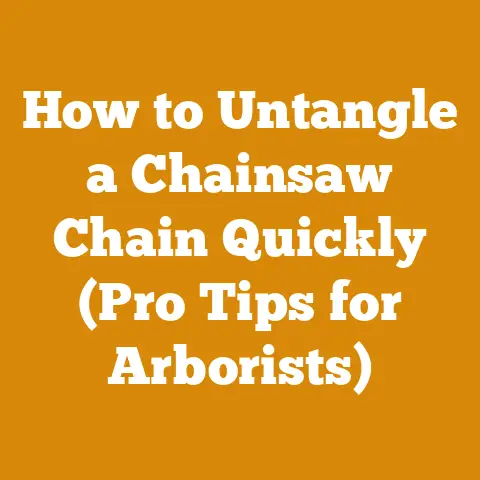Insurance for Tree Removal Business (Essential Coverage Tips for Arborists)
As someone deeply entrenched in the world of tree removal, logging, and firewood preparation, I understand firsthand the inherent risks involved. One slip, one miscalculation, and the consequences can be devastating. That’s why insurance isn’t just a piece of paper; it’s the bedrock of a sustainable and responsible tree removal business. This guide aims to demystify the often-complex world of insurance for arborists, providing you with essential coverage tips to protect your business and your livelihood.
Why Insurance is Non-Negotiable for a Tree Removal Business
Tree removal is consistently ranked among the most dangerous professions. We’re dealing with heavy machinery, precarious heights, unpredictable tree behavior, and the ever-present risk of property damage. A single accident can result in crippling financial losses, lawsuits, and even business closure. Insurance provides a crucial safety net, absorbing these risks and allowing you to operate with peace of mind.
Think of it this way: I once saw a seasoned arborist, with over 20 years of experience, misjudge a lean on a massive oak. Despite his best efforts, the tree landed slightly off target, damaging a homeowner’s fence and a parked car. Without adequate insurance, that mistake could have cost him everything he’d worked for. Insurance stepped in, covering the damages and preventing a financial catastrophe.
Decoding the Insurance Landscape: Key Coverage Types for Arborists
Navigating the world of insurance can feel overwhelming. Here’s a breakdown of the essential coverage types every tree removal business should consider:
1. General Liability Insurance: Your First Line of Defense
General liability insurance protects your business from financial losses resulting from bodily injury or property damage to third parties. This is arguably the most crucial coverage for any tree removal operation.
- What it covers: Accidents happening on the job site, damage to customer property (like the incident I mentioned earlier), and even injuries to bystanders.
- Why it’s essential: Imagine a falling branch damages a neighbor’s roof during a tree removal project. General liability insurance would cover the repair costs, preventing a potentially devastating financial blow to your business.
- Coverage levels: I recommend a minimum of \$1 million in coverage, but higher limits may be necessary depending on the scope and location of your work. Consider \$2 million or more if you frequently work in densely populated areas or with high-value properties.
- Cost factors: Premiums are influenced by your business size, location, claims history, and the types of services you offer.
2. Workers’ Compensation Insurance: Protecting Your Team
If you have employees, workers’ compensation insurance is usually legally required and absolutely ethically necessary. It covers medical expenses and lost wages for employees injured on the job.
- What it covers: Injuries sustained while performing tree removal tasks, such as chainsaw accidents, falls from heights, or injuries from falling debris. It also covers occupational illnesses developed as a result of the job, such as hearing loss from prolonged chainsaw use.
- Why it’s essential: Tree work is inherently dangerous. Workers’ compensation ensures your employees receive the care they need without burdening them financially. It also protects your business from lawsuits related to workplace injuries.
- State requirements: Workers’ compensation requirements vary by state. Ensure you comply with all applicable laws in your operating area.
- Experience modification rate (EMR): Your EMR reflects your company’s past workers’ compensation claims. A lower EMR means lower premiums, incentivizing you to prioritize safety. I’ve always prioritized safety training and invested in high-quality safety equipment, resulting in a consistently low EMR and significant savings on insurance premiums.
- Cost factors: Premiums are based on your payroll, the type of work your employees perform, and your EMR.
3. Commercial Auto Insurance: Covering Your Fleet
Commercial auto insurance protects your business vehicles, including trucks, chippers, and aerial lifts, from accidents, theft, and other damages.
- What it covers: Damage to your vehicles, injuries to drivers and passengers, and liability for damages caused to other vehicles or property in an accident.
- Why it’s essential: Tree removal businesses rely heavily on their vehicles. A single accident can put your entire operation on hold. Commercial auto insurance ensures you can quickly repair or replace damaged vehicles and continue operating.
- Coverage levels: I recommend a combined single limit (CSL) of at least \$1 million. This covers both bodily injury and property damage in a single policy limit.
- Hired and non-owned auto liability: This coverage protects you if you or your employees use personal vehicles for business purposes.
- Cost factors: Premiums depend on the types of vehicles you own, your driving record, the number of drivers, and the coverage limits you choose.
4. Professional Liability Insurance (Errors & Omissions): Protecting Your Expertise
Professional liability insurance, also known as errors and omissions (E&O) insurance, protects you from claims of negligence or errors in your professional services. While less common than general liability, it’s crucial for arborists providing consulting services or making tree care recommendations.
- What it covers: Claims arising from faulty advice, incorrect tree assessments, or negligent tree care practices. For example, if you recommend removing a tree that later proves to be healthy, and the homeowner suffers financial losses as a result, E&O insurance could cover the damages.
- Why it’s essential: Arborists are often relied upon for their expertise. E&O insurance protects you from liability if your professional advice leads to financial losses for your clients.
- Coverage levels: The appropriate coverage level depends on the scope of your consulting services and the potential financial impact of your advice.
- Cost factors: Premiums are influenced by your experience, qualifications, the types of services you offer, and your claims history.
5. Inland Marine Insurance: Protecting Your Equipment in Transit
Inland marine insurance covers your equipment while it’s being transported or stored off-site. This is particularly important for tree removal businesses that move equipment between job sites.
- What it covers: Damage or loss of equipment due to theft, vandalism, fire, or accidents during transportation. This can include chainsaws, ropes, climbing gear, and even larger equipment like chippers and stump grinders.
- Why it’s essential: Tree removal equipment is expensive. Inland marine insurance ensures you can quickly replace damaged or stolen equipment, minimizing disruptions to your business.
- Coverage levels: The coverage level should be sufficient to replace all of your covered equipment.
- Scheduled vs. blanket coverage: Scheduled coverage lists specific items and their value, while blanket coverage provides a general limit for all covered equipment. I prefer scheduled coverage for high-value items like chippers and stump grinders, and blanket coverage for smaller tools and equipment.
- Cost factors: Premiums are based on the value of your covered equipment, the types of risks you face, and your claims history.
6. Umbrella Insurance: Adding an Extra Layer of Protection
Umbrella insurance provides an extra layer of liability coverage above your existing policies. It kicks in when your other policies reach their limits, protecting you from catastrophic financial losses.
- What it covers: Liability claims that exceed the limits of your general liability, commercial auto, or employer’s liability policies.
- Why it’s essential: Lawsuits can be incredibly expensive. Umbrella insurance provides an extra cushion of protection, preventing a single lawsuit from bankrupting your business.
- Coverage levels: I recommend at least \$1 million in umbrella coverage, but higher limits may be necessary depending on the size and scope of your business.
- Cost factors: Premiums are relatively affordable compared to the coverage they provide.
Understanding Policy Exclusions: What Your Insurance Won’t Cover
It’s equally important to understand what your insurance doesn’t cover. Policy exclusions are specific situations or events that are not covered by your insurance policy.
- Common exclusions: Wear and tear on equipment, intentional acts, damage caused by faulty workmanship, and certain types of pollution.
- Importance of review: Carefully review your policy documents to understand all exclusions. Ask your insurance agent to explain any exclusions you don’t understand.
- Example: Most general liability policies exclude damage caused by faulty workmanship. If you improperly prune a tree, causing it to die, your insurance likely won’t cover the cost of replacing the tree.
Tips for Choosing the Right Insurance Policies
Selecting the right insurance policies for your tree removal business requires careful consideration. Here are some tips to guide you through the process:
1. Assess Your Risks: Identifying Potential Liabilities
The first step is to identify the specific risks your business faces. Consider the types of services you offer, the locations where you work, and the equipment you use.
- Risk assessment checklist:
- Working at heights
- Using chainsaws and other dangerous equipment
- Operating heavy machinery
- Working near power lines
- Removing trees in densely populated areas
- Providing consulting services
- Tailoring coverage: Once you’ve identified your risks, you can tailor your insurance coverage to address them specifically.
2. Shop Around: Comparing Quotes from Multiple Insurers
Don’t settle for the first insurance quote you receive. Shop around and compare quotes from multiple insurers to find the best coverage at the most competitive price.
- Independent agents: Consider working with an independent insurance agent who can represent multiple insurers. They can help you compare policies and find the best fit for your needs.
- Online comparison tools: Utilize online insurance comparison tools to get a quick overview of available options.
- Factors to compare: Coverage levels, premiums, deductibles, exclusions, and the insurer’s reputation and financial stability.
3. Read the Fine Print: Understanding Policy Language
Insurance policies can be complex and filled with legal jargon. Take the time to carefully read and understand the policy language before you sign on the dotted line.
- Key terms: Pay close attention to key terms like “occurrence,” “aggregate limit,” “deductible,” and “exclusion.”
- Ask questions: Don’t hesitate to ask your insurance agent to explain any terms or conditions you don’t understand.
- Seek legal advice: If you’re unsure about any aspect of your policy, consider seeking legal advice from an attorney specializing in insurance law.
4. Maintain Accurate Records: Documenting Your Operations
Maintaining accurate records of your operations is crucial for insurance purposes. This includes documenting your safety procedures, employee training, equipment maintenance, and any incidents or accidents that occur.
- Documentation checklist:
- Safety manuals
- Training records
- Equipment maintenance logs
- Incident reports
- Photos and videos of job sites
- Contracts with clients
- Benefits of documentation: Accurate records can help you prove compliance with safety regulations, defend against liability claims, and negotiate better insurance rates.
5. Regularly Review Your Coverage: Adapting to Changing Needs
Your insurance needs may change over time as your business grows and evolves. Regularly review your coverage to ensure it continues to meet your needs.
- Triggering events: Review your coverage whenever you experience significant changes in your business, such as:
- Adding new employees
- Purchasing new equipment
- Expanding your service offerings
- Working in new locations
- Annual review: At a minimum, review your insurance coverage annually with your insurance agent.
Safety First: Reducing Risks to Lower Insurance Costs
One of the best ways to lower your insurance costs is to reduce your risks. By prioritizing safety and implementing effective risk management strategies, you can minimize the likelihood of accidents and claims.
- Training topics:
- Chainsaw safety: Proper use, maintenance, and personal protective equipment (PPE). I personally recommend Stihl chainsaws for their reliability and safety features. I always emphasize the importance of wearing chaps, a helmet with a face shield, and hearing protection when operating a chainsaw.
- Climbing techniques: Safe climbing practices, rope management, and fall protection.
- Rigging procedures: Proper rigging techniques for lowering branches and trees safely. I’ve found that using high-quality ropes and hardware from reputable brands like Yale Cordage and Petzl is essential for safe and efficient rigging.
- Emergency response: First aid, CPR, and emergency communication protocols.
- Certification: Consider obtaining certifications from reputable organizations like the Tree Care Industry Association (TCIA) or the International Society of Arboriculture (ISA).
- Regular refreshers: Conduct regular refresher training to reinforce safety procedures and address any new hazards or challenges.
2. Investing in High-Quality Equipment: Ensuring Reliability and Safety
Invest in high-quality equipment that is well-maintained and meets all safety standards. This includes chainsaws, climbing gear, rigging equipment, and personal protective equipment (PPE).
- Equipment checklist:
- Chainsaws: Choose chainsaws with safety features like chain brakes and anti-vibration systems.
- Climbing gear: Use harnesses, ropes, and carabiners that meet ANSI standards.
- Rigging equipment: Select ropes, slings, and pulleys that are rated for the loads you’ll be lifting.
- PPE: Provide employees with appropriate PPE, including helmets, eye protection, hearing protection, gloves, and chainsaw chaps.
- Regular maintenance: Establish a regular maintenance schedule for all equipment to ensure it’s in good working order.
- Equipment inspections: Conduct daily inspections of all equipment before each use to identify any potential problems.
3. Implementing Safe Work Practices: Minimizing Risks on the Job Site
Implement safe work practices to minimize risks on the job site. This includes establishing clear communication protocols, using proper flagging and barricading techniques, and conducting thorough site assessments before starting work.
- Safe work practices:
- Communication: Use clear and concise communication signals to coordinate tasks and avoid misunderstandings.
- Flagging and barricading: Use flagging and barricades to create a safe work zone and prevent unauthorized access.
- Site assessments: Conduct thorough site assessments before starting work to identify potential hazards, such as power lines, underground utilities, and unstable trees.
- Drop zones: Establish clear drop zones for branches and debris to prevent injuries and property damage. I always ensure the drop zone is clear of people and obstacles before cutting any branches.
- Job Hazard Analysis (JHA): Conduct a Job Hazard Analysis (JHA) before each job to identify potential hazards and develop strategies to mitigate them.
4. Maintaining a Clean Safety Record: Demonstrating Your Commitment to Safety
Maintaining a clean safety record is essential for reducing insurance costs. This means avoiding accidents, injuries, and property damage claims.
- Incentive programs: Consider implementing incentive programs to reward employees for safe work practices.
- Disciplinary action: Take disciplinary action against employees who violate safety rules.
- Post-accident reviews: Conduct thorough post-accident reviews to identify the root causes of accidents and implement corrective actions to prevent future occurrences.
Case Studies: Real-World Examples of Insurance in Action
To illustrate the importance of insurance, let’s examine a few real-world case studies:
Case Study 1: The Unexpected Windstorm
A tree removal business was hired to remove a large oak tree from a residential property. During the removal process, an unexpected windstorm blew through the area, causing the tree to fall in the wrong direction and damage the homeowner’s garage.
- Insurance coverage: General liability insurance covered the cost of repairing the damaged garage.
- Lessons learned: This case highlights the importance of having adequate general liability coverage to protect against unforeseen events.
Case Study 2: The Chainsaw Accident
An employee of a tree removal business was injured while operating a chainsaw. He suffered a deep laceration to his leg.
- Insurance coverage: Workers’ compensation insurance covered the employee’s medical expenses and lost wages.
- Lessons learned: This case underscores the importance of workers’ compensation insurance to protect employees from workplace injuries.
Case Study 3: The Stolen Chipper
A tree removal business had their chipper stolen from a job site overnight.
- Insurance coverage: Inland marine insurance covered the cost of replacing the stolen chipper.
- Lessons learned: This case demonstrates the importance of inland marine insurance to protect against the loss of valuable equipment.
Even with the best safety precautions, accidents can still happen. Knowing how to navigate the claims process is crucial for minimizing the financial impact of an accident.
1. Report the Accident Immediately: Timely Notification is Key
Report the accident to your insurance company as soon as possible. Provide them with all the necessary information, including the date, time, and location of the accident, a description of what happened, and the names and contact information of any witnesses.
2. Document Everything: Gathering Evidence for Your Claim
Document everything related to the accident, including photos, videos, and written statements. This documentation will be crucial for supporting your claim.
3. Cooperate with the Insurance Company: Providing Accurate Information
Cooperate fully with the insurance company’s investigation. Provide them with all the information they request in a timely manner.
4. Seek Legal Advice if Necessary: Protecting Your Rights
If you’re unsure about your rights or if you’re having trouble with the claims process, seek legal advice from an attorney specializing in insurance law.
Strategic Insights: Beyond Basic Coverage
Beyond the basic coverage types, there are some strategic insights that can help you optimize your insurance program:
- Risk transfer: Consider transferring some of your risks to subcontractors by requiring them to carry their own insurance.
- Contractual liability: Review your contracts with clients to ensure they don’t contain any clauses that could increase your liability.
- Loss control services: Take advantage of the loss control services offered by your insurance company. These services can help you identify and mitigate potential risks.
- Group purchasing: Consider joining a group purchasing organization to negotiate better insurance rates.
Conclusion: Investing in Peace of Mind
Insurance is an essential investment for any tree removal business. By understanding the different types of coverage available, choosing the right policies, and implementing effective risk management strategies, you can protect your business from financial losses and operate with peace of mind. Remember, insurance isn’t just an expense; it’s an investment in the long-term sustainability and success of your business.
As a final thought, I encourage you to view insurance as a partnership. By working closely with your insurance agent and prioritizing safety, you can build a strong relationship that benefits both your business and your insurance provider. The peace of mind that comes with knowing you’re adequately protected is invaluable in this demanding and often unpredictable industry.






